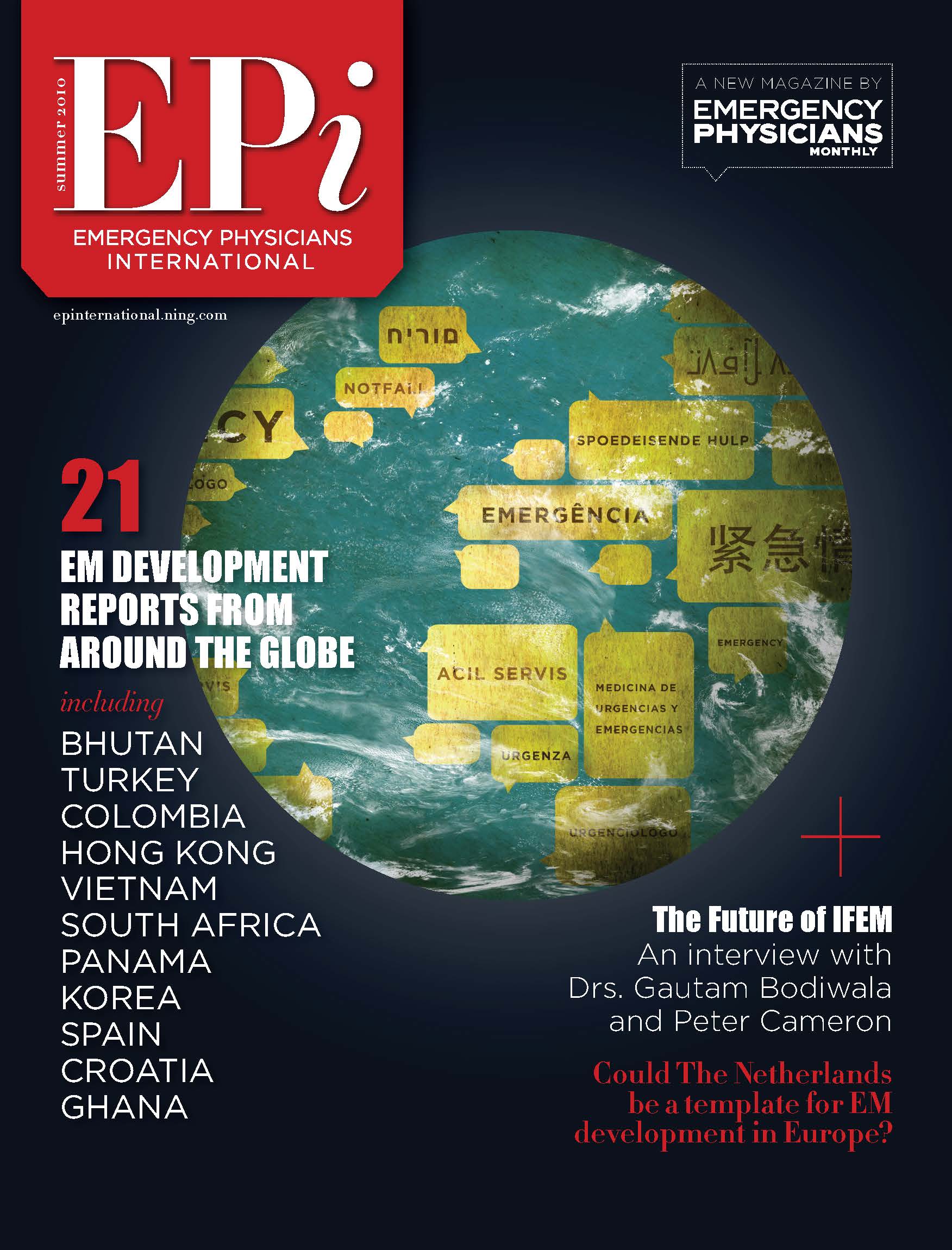COVID Lays Bare an Emergency Medicine Crisis
The following is the second installment of a 2-part op/ed. Read part one HERE.
The following op-ed piece was transcribed from an audio recording, and lightly edited for clarity by L. Esther Hibbs, Managing Editor.
Many people who are involved in emergency medicine got into it for the right reasons: wanting to help people, wanting to be able to take care of anyone, anything, anytime, being able to offer assistance when nobody else has been able to in the healthcare system. However, the emergency department has turned into something else. It has been turned into an overflow pressure valve on a mismanaged hospital system, like on a bathtub. If the hospital is getting full or if it's too expensive to staff a hospital the way it should be, hospitals turn the emergency department into an extra catchment area. Hospitals should be run at 85% capacity with a lot of room for overage and surges, with a system for calling in extra staff and capabilities when necessary. Instead, hospitals often choose to run on very thin margin: 95% capacity, shutting down wards and wings of the hospital on a weekly or monthly basis because of the cost of staffing. Emergency departments then swell and become overcrowded.
One of the characteristics of the emergency department is an open front door. You cannot close the front door and we do not want to close the front door. We want to be open 24/7/365 for anyone, anything, anytime. The problem is, the back door of the ER is often closed, at least partially. Therefore, when people come in, they’re seen by emergency physicians and the emergency professionals and we do our emergency care and we make a decision of whether the patient needs to be admitted or whether they are able to be discharged. We intend to provide definitive care or appropriate care with definitive care to follow such as at referral clinics, et cetera. However, when we make the decision to admit, we often cannot because the hospital is mismanaged or full because of mismanagement. We can't make proper decisions of proper follow-up. Sending patients to other primary care doctors, specialists, social workers, behavioral health resources, or drug and substance abuse referral agencies is often dysfunctional because those agencies are not staffed well. After their initial acute, episodic treatment, patients come right back to us because of improper admission capability or improper follow up. We really are Jacks of all trades, and we are being taken advantage of.
This is the situation I think that this pandemic has shined a giant spotlight on: the emergency department is taking care of much more than just sick people. The department takes care of hospital problems, staffing problems, hospital management problems, insurance problems, economic problems, social problems and we're really the catch all of the healthcare system. A lot of this contributes to the emergency system being run in the red for too long.
Every now and then, a crisis such as this once in a hundred year viral pandemic comes on. However, the crisis of emergency medicine is not a one in a hundred year crisis-- it is ongoing. This pandemic is just pulling the curtain aside to show the real state of the emergency system: it is running on fumes. People are running to take care of too many patients. I often think of the video of Lucille Ball and Ethel Mertz from the I Love Lucy show, where they are standing at the conveyor belt trying to wrap up chocolate. I think that is a good analogy of us in the emergency department. We do incredible work. We see patient after patient. Fifty one percent of all hospital care in the USA is delivered in the emergency department, and one third of all the patients who come in the emergency department are sick enough to be admitted. Additionally, between sixty and eighty percent of all hospital income comes from emergency department admissions. Therefore, within the hospital, the emergency department is the economic engine, the admissions engine, and the patient safety engine. When we do things right in the emergency department, it makes the whole hospital run better.
When we run the emergency department well, we diagnose and stabilize patients as much as we can. That makes a hospital run better. We streamline systems hospital by hospital, it makes all the hospitals run better. In turn, the situation on the floor of the hospital becomes a slow simmering boil instead of a rolling boil flowing over the top of the pan. Emergency physicians provide tremendous value to our patients’ safety, and to hospitals’ stability. Despite this, emergency physicians do not own or control the value we create. Our created value has been usurped and taken away from emergency physicians, then dispersed to contact management groups, hospital management groups, insurance companies, and other administrative groups. Each of these parties is taking the value created by emergency physicians, profiting off of it, and sometimes mis-managing it. We are then asked to work harder: to pick up the slack and take care of more and more. Imagine a hospital with an emergency department on the first floor. The patients come in the front door of the hospital: the ER. They don't go into the hospital correctly and they don't get out of the hospital directly. The emergency department is left getting more and more full. The patients only get sicker. It is like stepping on a hose. You step on the hose and it starts to swell, but there's only so much swelling the system can handle. I think the emergency department in almost every hospital is running at or very near the breaking point. The COVID-19 crisis has pushed us over the edge. It is a curse, but also brings blessings by forcing everyone outside our environment to cast the curtain aside and see what is truly happening.
The pandemic has revealed how our healthcare systems lead to mismanaged emergency rooms, and exploited emergency physicians. The people who are employing emergency departments are benefiting off the extreme value we offer. They are not reinvesting that value in emergency departments, but instead taking advantage of it and asking for more. That is part of what led to the burn out we see in emergency physicians. Fifty years ago, the people who were working in emergency departments were not trained in emergency medicine because there was no formal training. After the first fifteen or so years of training, we found burnout levels went down amongst emergency physicians because they were trained. It makes sense that if you train people to work in a certain stressful environment and show them how to manage some chaos, their stress levels go down. Unfortunately, burnout rates have gone up again in the last ten or so years, particularly for emergency physicians.
The reason for an increase in burnout is not because doctors have an imbalance between work and home life, nor is it due to a lack of proper mindfulness. We are suffering from abuse. In a sense, burnout is not the proper term because it places all the blame on the victim. It would be like blaming soldiers for the shell shock or post-traumatic stress disorder they have endured. Burnout is not the fault of the physician. Burnout is abuse. Emergency health professionals of all titles are being abused. The department is suffering abuse by systems: corporations, insurance companies, hospitals. There is only so much more abuse that we can take before the system will crack. In this way, though the underlying crisis has been made worse by the pandemic, we can now shine a big spotlight on the harsh realities of emergency medicine right now.
This crisis offers the opportunity to position ourselves as individuals and the greater emergency medicine organizations to respond well to this crisis-- not just the pandemic, but the underlying emergency medicine crisis. Then, if and when things re-normalize, we can move forward to a new normal: a better normal. Somebody did a study of CPR and defibrillation depictions on television and in the movies. The study showed that on television, something like eighty percent of people who undergo CPR wake up, start walking, and are fine. Real statistics show CPR is usually not successful. The real survival rate is more like fifteen percent than eighty. There is an analogy here for the emergency system. Right now, the emergency system is undergoing CPR. The emergency system is failing its stress test. When you push the emergency system too far, not only does it threaten itself but it poses a risk to the general healthcare system because of its crucial role. So it's like a stress test: a patient undergoing a stress test whose heart and system can't handle running at their peak speed will sometimes collapse and have a heart attack. Our community is on the brink of that happening.
In the past I've always said running an emergency patient through the healthcare system is like a stress test for the hospital. This pandemic is like a stress test for the whole healthcare system. The results are in, and we see the emergency system failing. Emergency care has been run at near capacity or overcapacity levels for decades. Now, this crisis is pulling the curtain aside and shining a spotlight on the long term effects of this chronic mismanagement. As a board member of the American Academy of Emergency Medicine, as a vice president of the International Federation for emergency medicine, and as somebody who's been helping build emergency medicine systems in over forty countries for the last twenty years, I'm very concerned. I am concerned about building sustainable emergency systems in other countries, so they don't fall victim to their own success the same way we have here in our country.






